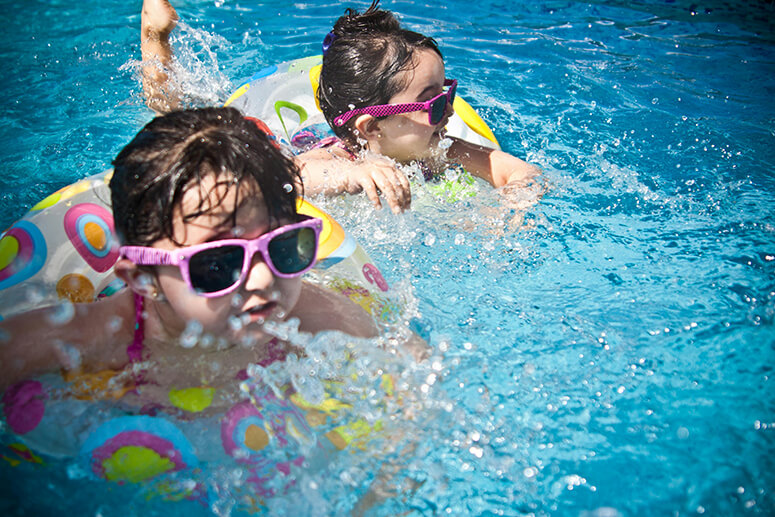Pepper Lozada dives into the unmatched benefits of swimming
If you want to learn how to swim, you would most likely go to the Bert Lozada Swim School founded by Remberto C. Lozada, or "Tito Bert,” who formulated and implemented his own style of teaching swimming in 1956 at the YMCA Manila.
Three generations of Lozadas have since been involved in the sports, either as competitor, teacher, or coach. Tito Bert’s method was a combination of lessons from his father and his own learnings from his exposure to international swimming competitions.
His passion for the sport, strict discipline, and emphasis on stroke mechanics not only produced an effective method of teaching but also developed champions in competitive swimming.

We reached out to his daughter-in-law who heads the Infant and Toddler Aquatic department of the swim school, Pepper Angeles-Lozada, to share some thoughts about the sport as an exercise.
The Philippine STAR: What are the primary benefits of swimming as a regular form of exercise and how does it compare to other cardiovascular activities?
COACH PEPPER ANGELES-LOZADA: Swimming is one of the most well-rounded exercises you can do from a holistic health and wellness perspective. First off, it’s incredibly joint-friendly. Since water supports most of your body weight, there’s minimal impact on your joints, making it ideal not just for athletes but also for older adults or anyone recovering from an injury. Unlike running or cycling which mostly target the lower body, swimming works the entire body—upper body, legs, and core—all at once. That means you are building muscular strength and endurance while also getting your cardio in. Cardiovascularly, it’s powerful! It improves both heart and lung capacity and tends to enhance oxygen efficiency more than most other cardio workouts. Mentally, it’s a game-changer! There’s something calming about being in the water. It reduces stress, helps with anxiety, and even improves sleep.

Calorie-wise, it burns just as much as running or cycling, sometimes more, but with less strain and sweat. And because of how the body regulates temperature in water, you get a mild metabolic boost, too. One of the underrated benefits is how it improves posture and flexibility. Each stroke stretches and elongates the muscles, which helps with spinal alignment. Compared to other forms of cardio, swimming might take more effort to access since you need a pool, but it offers a rare mix of cardio, strength, mobility, and mental clarity. If you're looking for a single activity that covers almost every aspect of fitness: physical, mental, and emotional… then swimming is tough to beat.
Some people struggle with consistent motivation or hitting plateaus in their fitness journey. What can you advice swimmers or aspiring swimmers in terms of staying engaged to continuously progress in their training?
Plateaus and dips in motivation are part of the game, whether you're a beginner or a seasoned swimmer. The key is not to avoid them, but knowing how to push through them strategically. Here's how swimmers or those using swimming as a form of exercise can stay engaged and continue progressing, both in and out of the water:
1. Shift the focus from “harder” to “smarter.” Many swimmers hit plateaus because they only swim laps without intention. Instead, set a clear focus each week—technique one day, speed another, distance another. Use drills, interval sets, and stroke count tracking to make workouts purposeful. Quality over quantity.
2. Set micro-goals. Don’t rely on big goals like "win a race" or "lose 10 kg." Break them into specific, trackable yet sustainable micro-goals: Drop 2 strokes per lap over 50m freestyle. Hold a 1:45 split on 5 x 100m. Train 3x this week, no skips. Small wins build momentum and momentum sustains motivation.
3. Rotate your training stimulus. Change your sets every four to six weeks. Add resistance tools by adding fins, paddles, drag socks. Swim with a team. Or switch strokes. For dry-land, cycle between power (e.g., med ball slams), strength (pull-ups, squats), and mobility blocks. The body adapts fast. Keep your muscles guessing.
4. Train yiur mind like you train your body. Motivation fades, discipline doesn’t! Build habits. Set a schedule. Show up even when you don’t feel like it, especially then. Add accountability: Train with a partner, join a masters’ group, or log your workouts publicly. On tough days, remember this: You don’t have to be the fastest… just the most consistent.
5. Make it personal. Reconnect with why you're swimming. Is it fitness? Mental clarity? A personal milestone? Keep that “why” visible. Literally, if you have to. On days when motivation is zero, your why is the only thing that will get you in the pool!
What are some misconceptions about swimming and how will you encourage someone who might be hesitant to try swimming as part of their fitness regimen?
There are several common misconceptions about swimming that hold people back and most of them are rooted in misunderstanding what swimming really is.
Misconception 1: “Swimming is only for athletes or people who already know how to swim.” Swimming is one of the most scalable activities you can do. You don’t need to swim fast. You just need to get in and move. You can walk in shallow water, do basic floating drills, or swim short laps at your own pace. It's not about speed or skill at the start. It's about movement and consistency.
Misconception 2: “Swimming doesn’t burn as many calories as running or gym workouts.” Swimming can burn just as many, if not more, calories than running, especially when done with intensity or longer duration. Plus, it works the entire body: arms, legs, core, lungs, and heart all at once. And because it is low-impact, you can do it more frequently without joint fatigue.
Misconception 3: “I’ll never improve. It’s too technical.” Like any other skills, swimming improves with small, consistent inputs. Start with the basics: floating, breathing, and proper body position. Technique doesn’t need to be perfect. It just has to be good enough to keep you safe and moving. Drills, coaches, and even YouTube can help you improve quickly.
Misconception 4: “Swimming is boring.” If you're just doing endless laps, maybe. But when you break your sessions into intervals, drills, challenges, or swim with others, it becomes dynamic. It’s like lifting weights. You don’t do the same set over and over.
Misconception 5: “I’m too old to learn how to swim.”Age has nothing to do with learning how to swim. In fact, many adults learn faster than children because they can follow instructions better and have clear goals. There are beginner-friendly programs specifically designed for adults, and progress often comes in weeks, not years. Plus, swimming is one of the safest, lowest-impact ways to stay fit as you age.
Start where you are. Swimming doesn’t demand perfection, just patience and consistency. It’s one of the few forms of exercise that’s kind to your body while delivering real results: cardio fitness, full-body strength, flexibility, mental clarity, and longevity. Plus, it’s a survival skill! The earlier you start, the sooner it becomes second nature.


